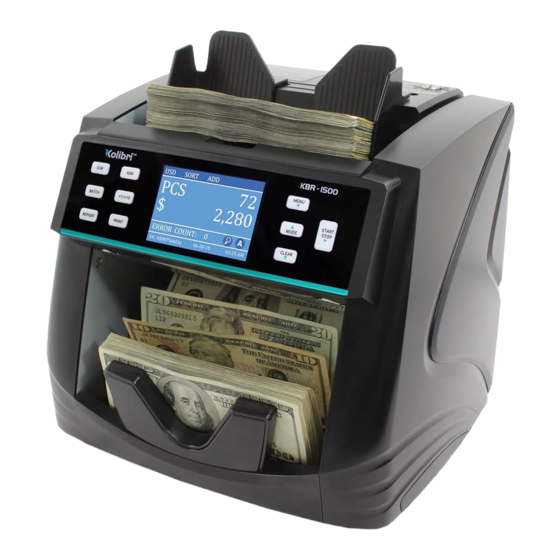Advertisement
KBR-1500
Feed Gap Adjustment
Sometimes, during the transportation or shipment of the unit, the adjustment of the feed
mechanism may loosen. This can also happen during normal wear or tear and can lead to
DOUBLE, CHAIN or HALF errors. The feed gap is the actual height of the bill feed path, and
should be tuned to just about the thickness of a single bill. If the feed gap is too wide, the
user may experience a high amount of DOUBLE and CHAIN errors which are caused by
more than one bill entering the scanning path at one time. If the feed gap is too tight, the
unit may not be able to pass bills into the scanning path, or catch on bills and tear them.
The following steps are the procedure for adjusting the feed gap:
1. Ensure the machine is turned off.
2. Position the rollers so that none of the dark-colored rubber teeth are visible. This can be
done by turning the kick rollers. Only the black smooth sections of the rollers
should be showing.
Incorrect Position:
Turn rollers until teeth are no longer visible.
3. Place one bill that is crisp and rigid enough to prevent bending during the adjustment
procedure. Place the bill lengthwise either to the right or left side of the hopper.
See image below for example.
KB-081120
Correct Position:
2020 Kolibri USA
Advertisement
Table of Contents

Subscribe to Our Youtube Channel
Summary of Contents for Kolibri KBR-1500
- Page 1 3. Place one bill that is crisp and rigid enough to prevent bending during the adjustment procedure. Place the bill lengthwise either to the right or left side of the hopper. See image below for example. KB-081120 2020 Kolibri USA...
- Page 2 1 dot at a time, then retest. Important Note: The KBR-1500 feed gap adjustment can be sensitive during adjustments. Do not overturn each adjustment or you may overshoot the optimum gap. We recommend testing with a stack of bills after each adjustment turn.









Need help?
Do you have a question about the KBR-1500 and is the answer not in the manual?
Questions and answers